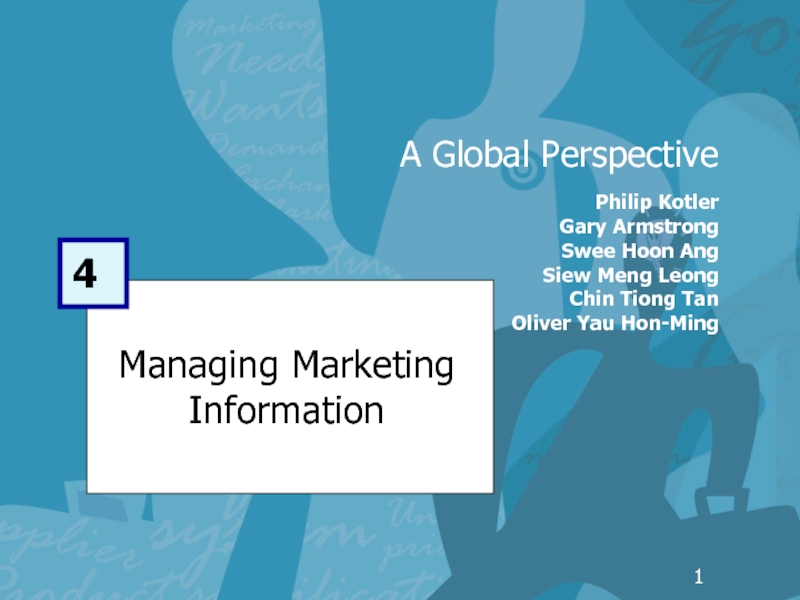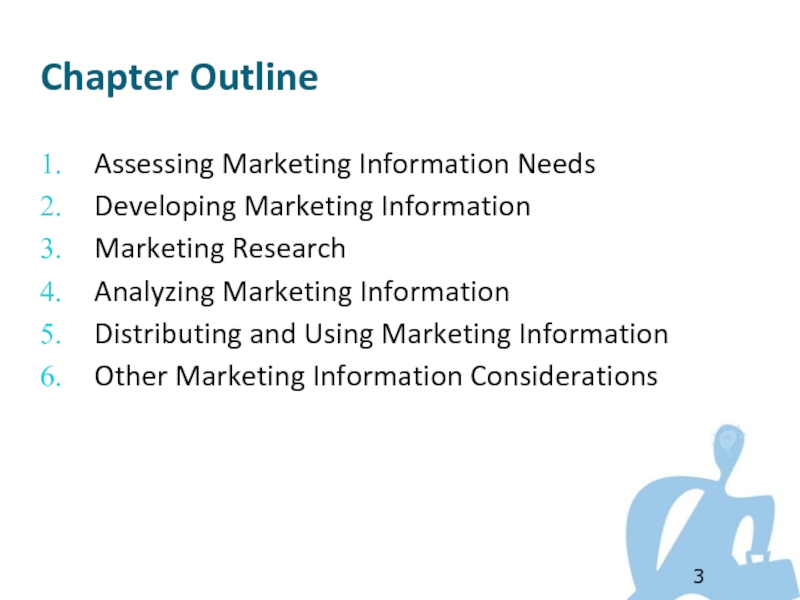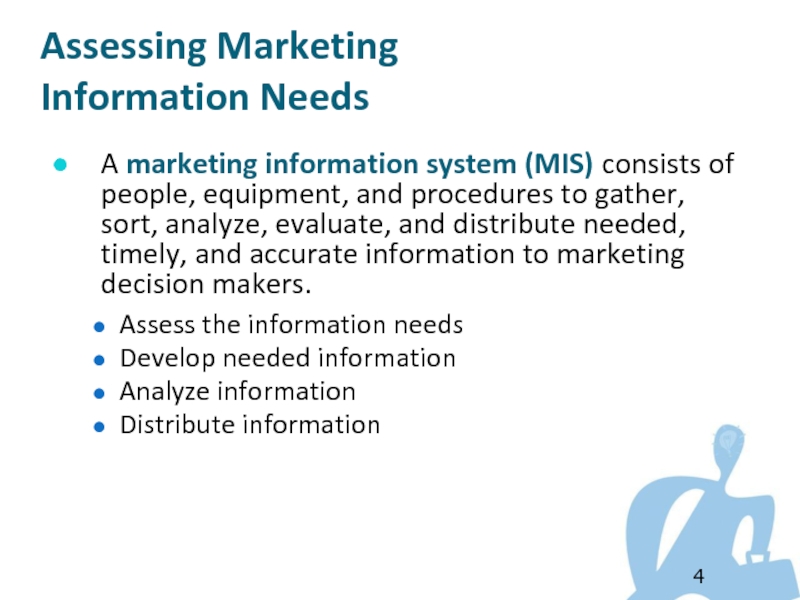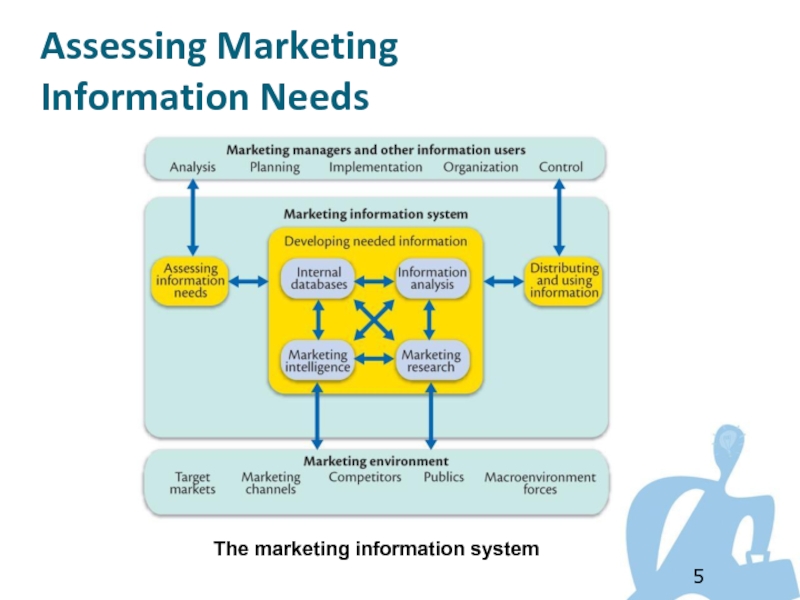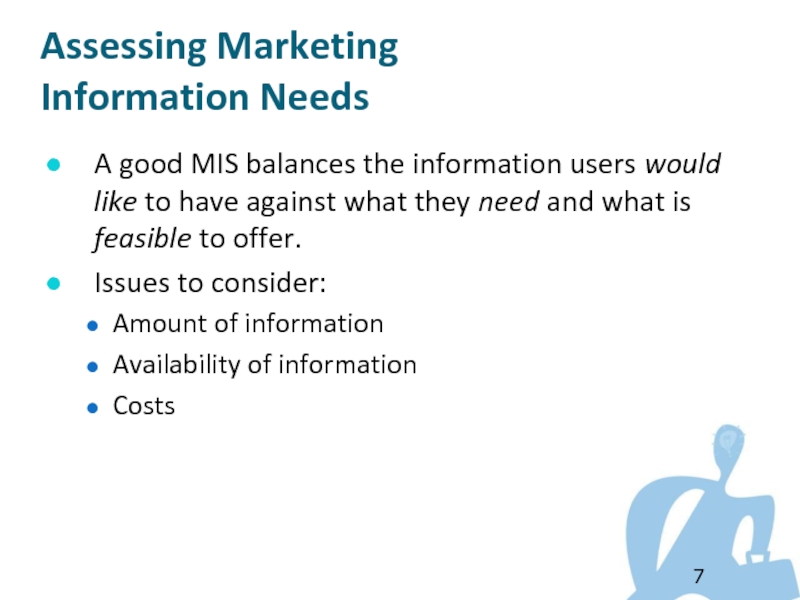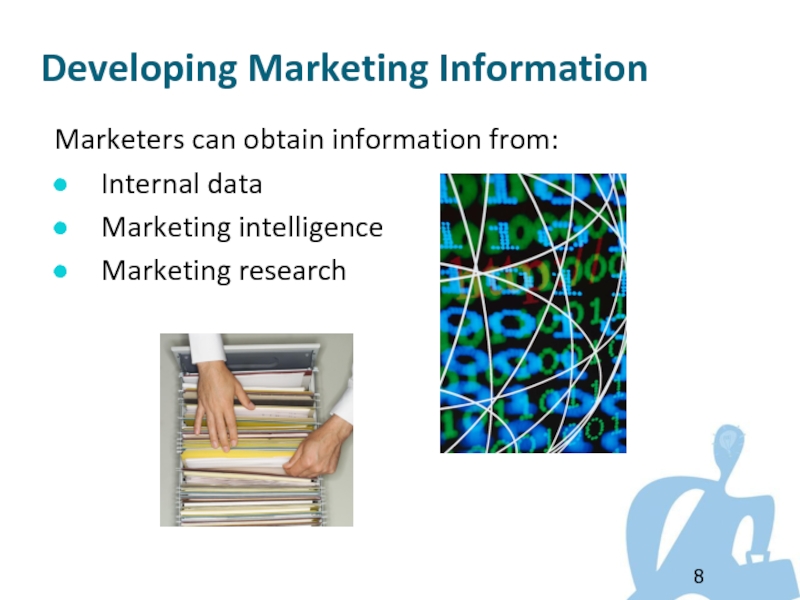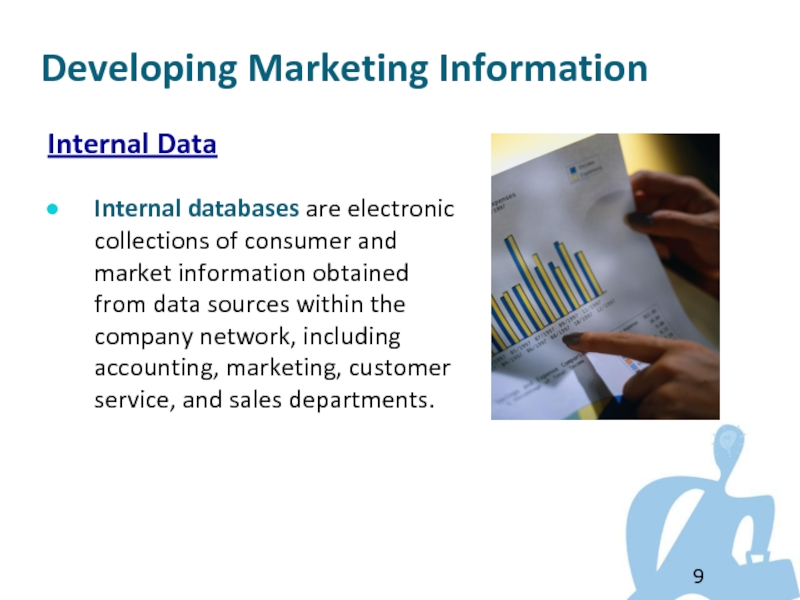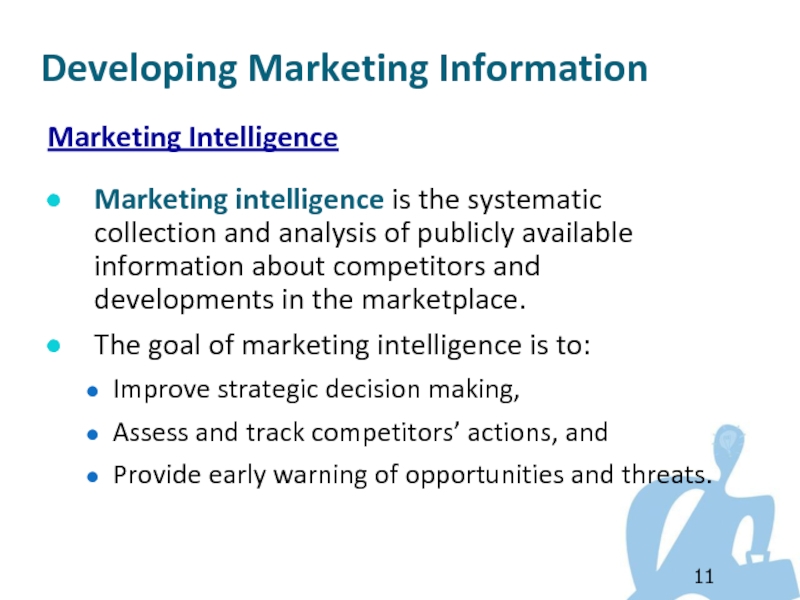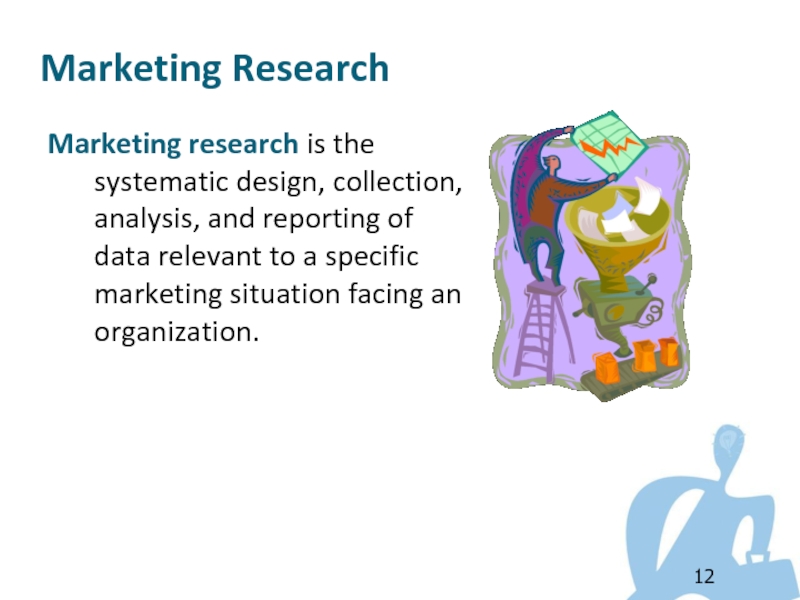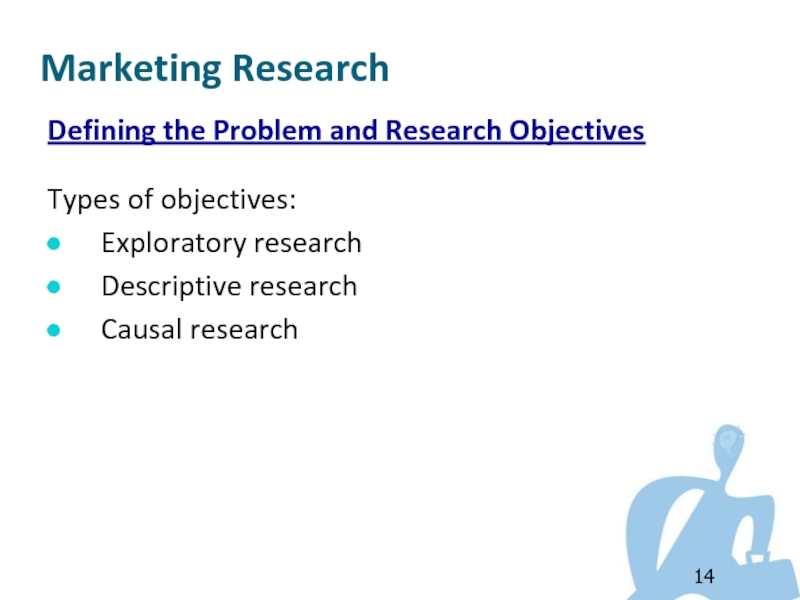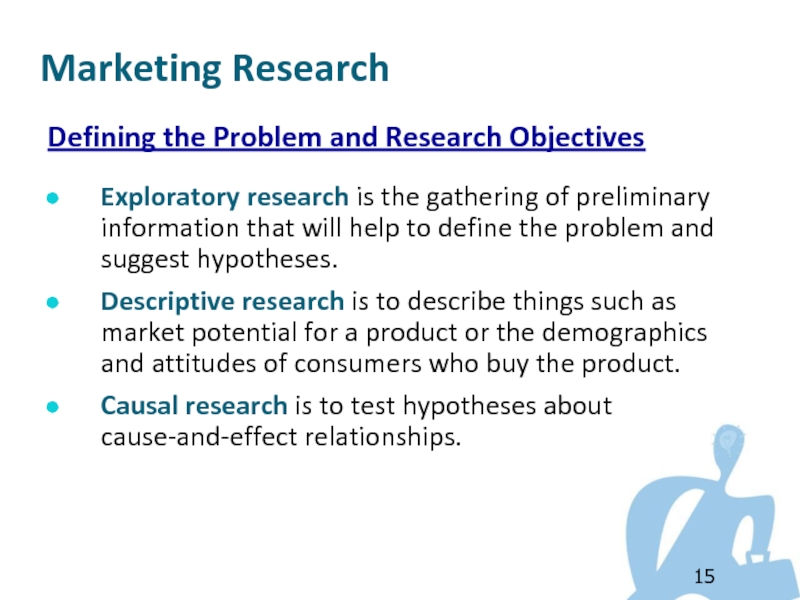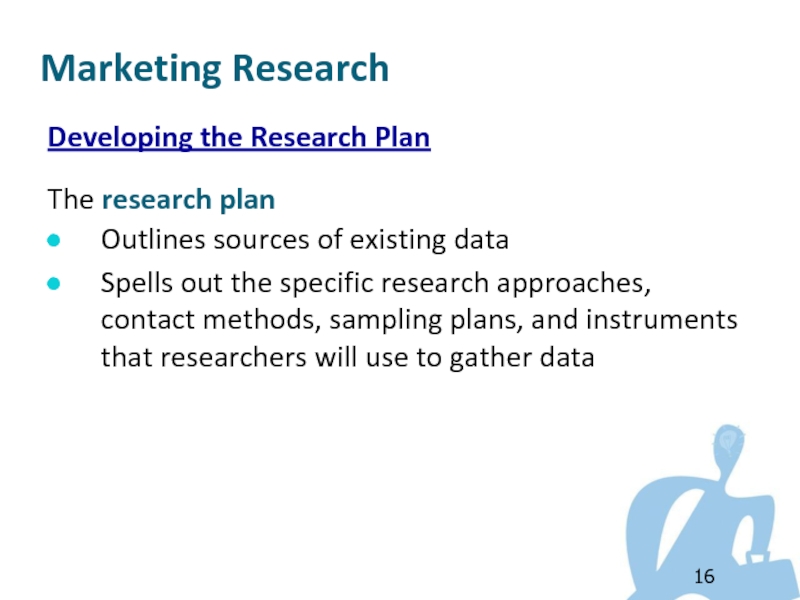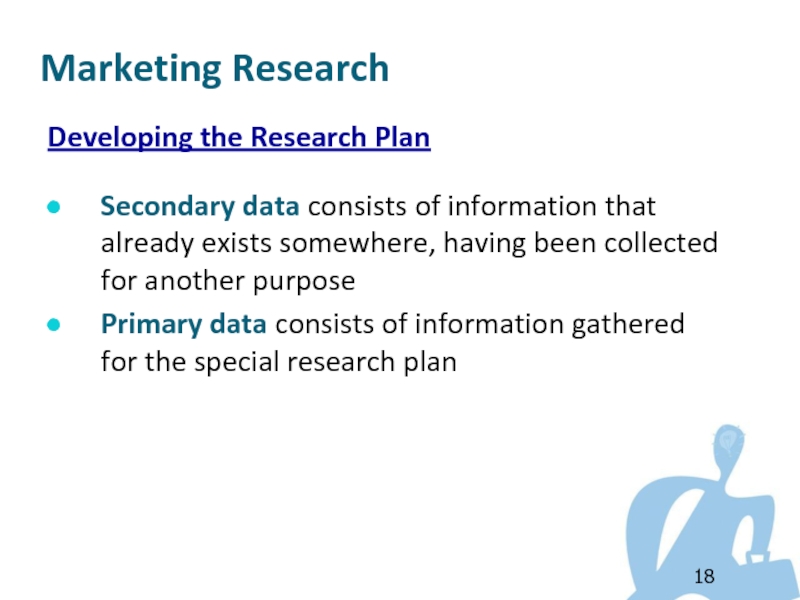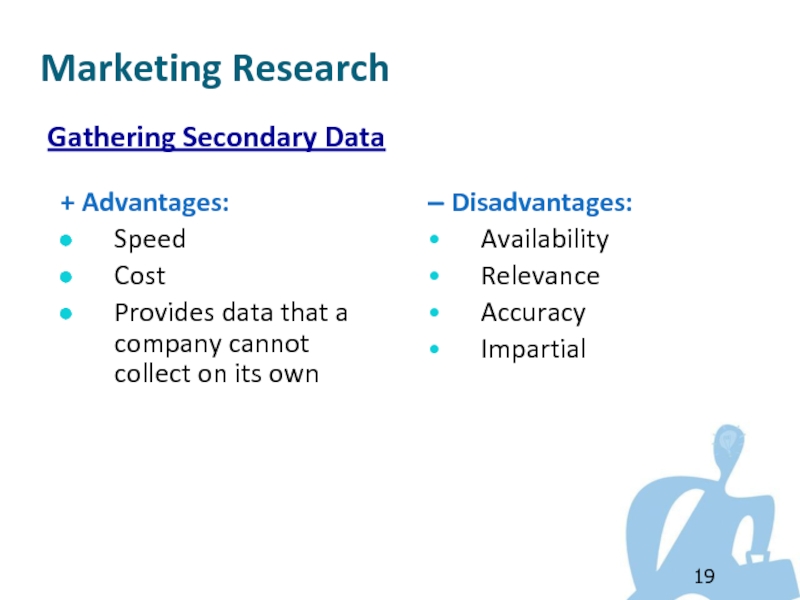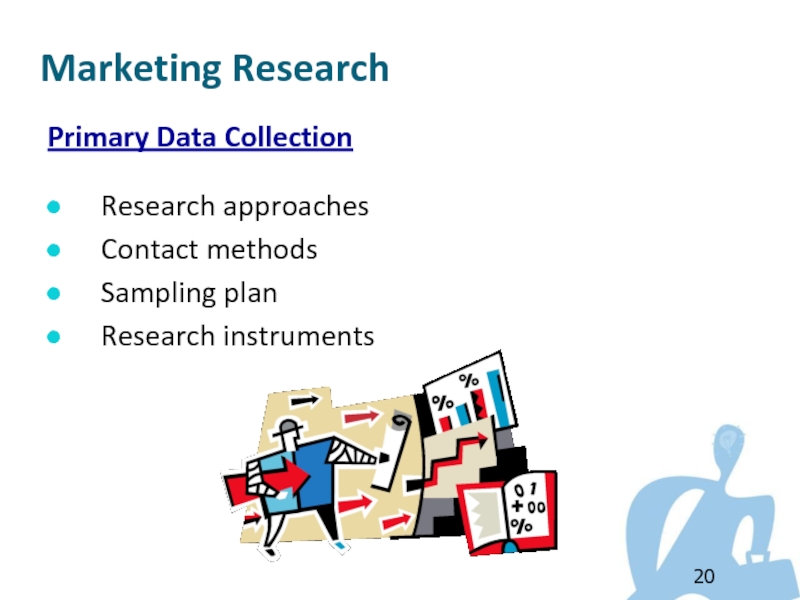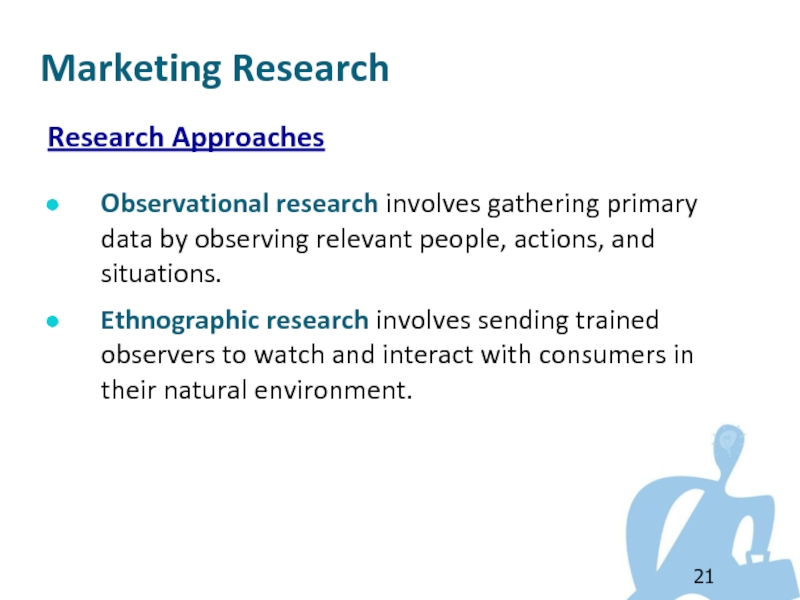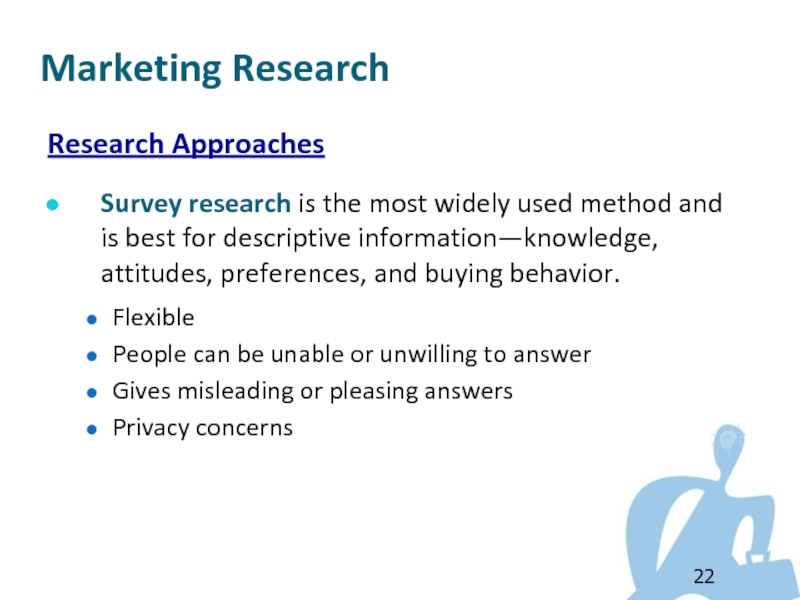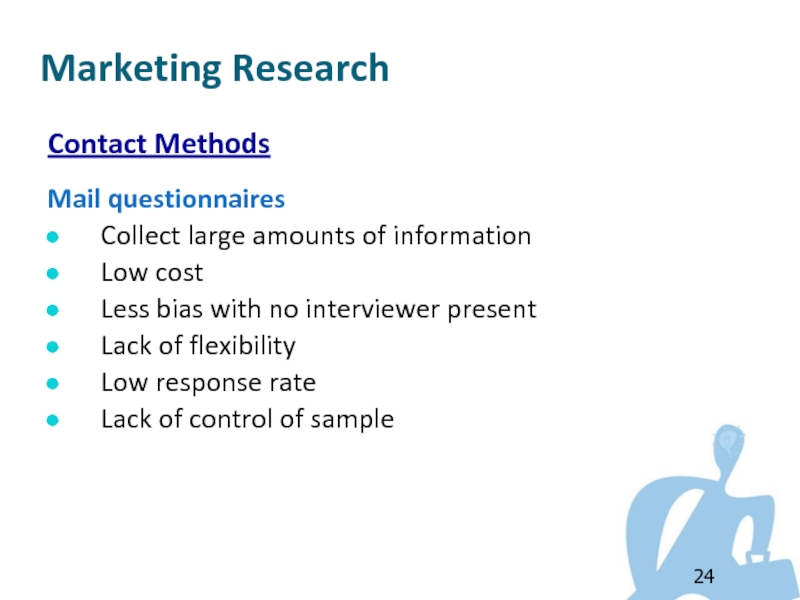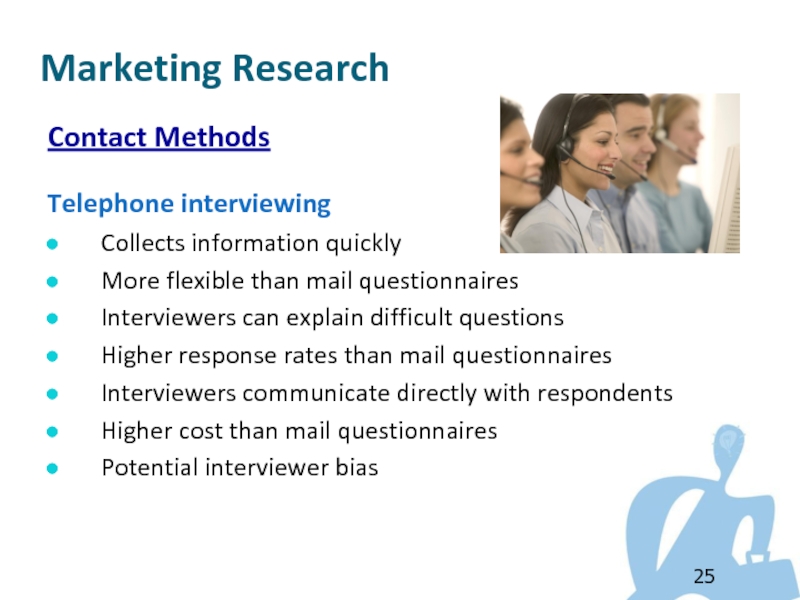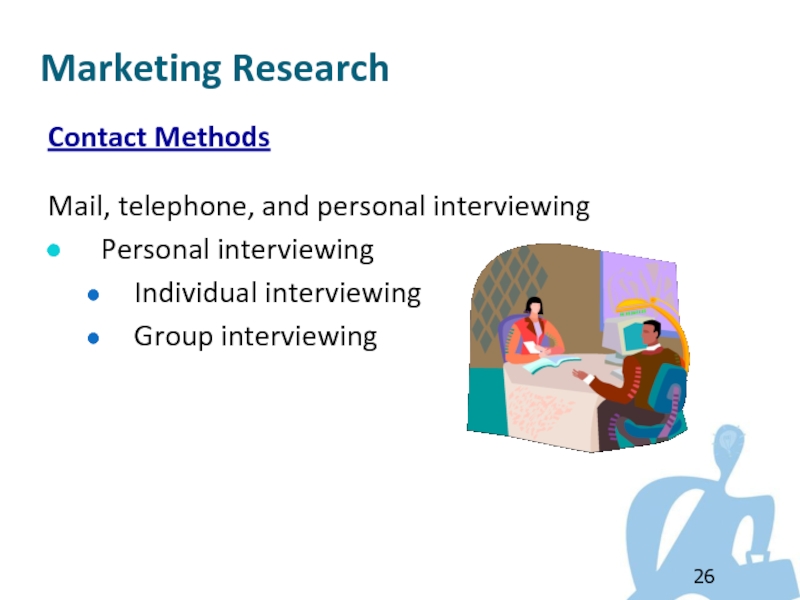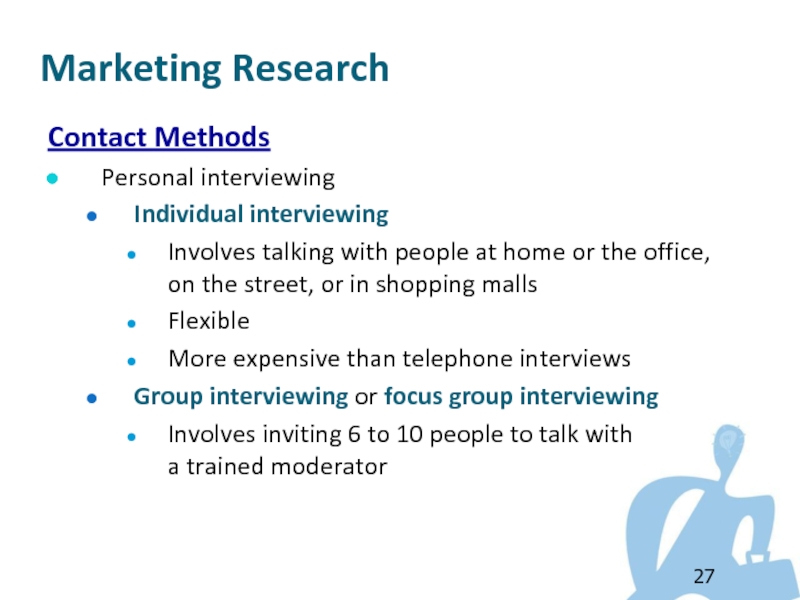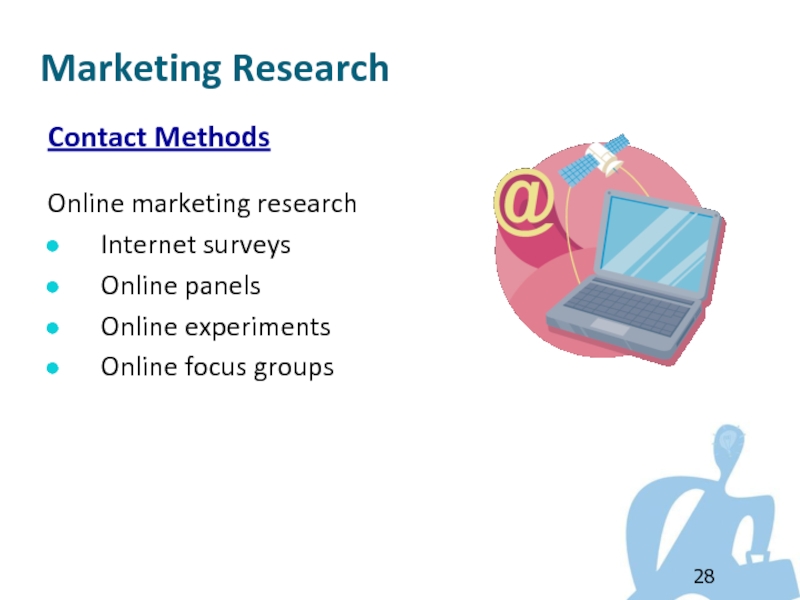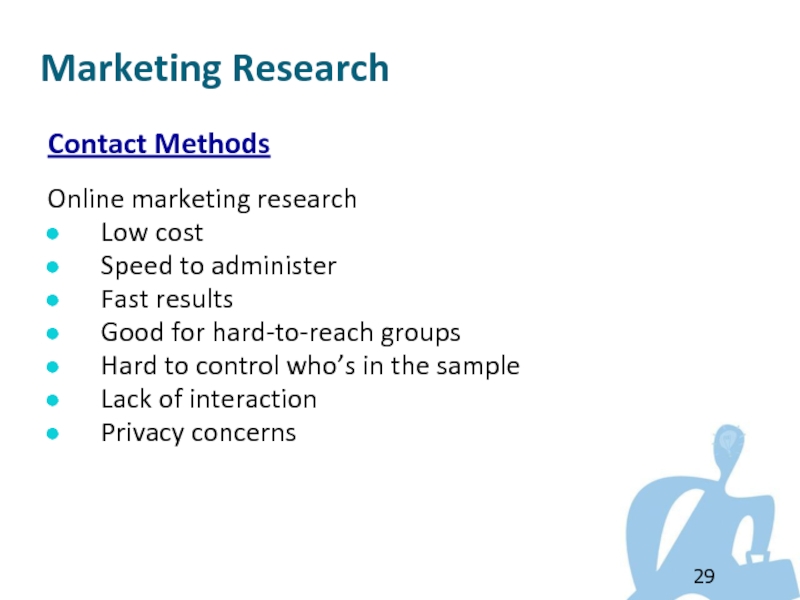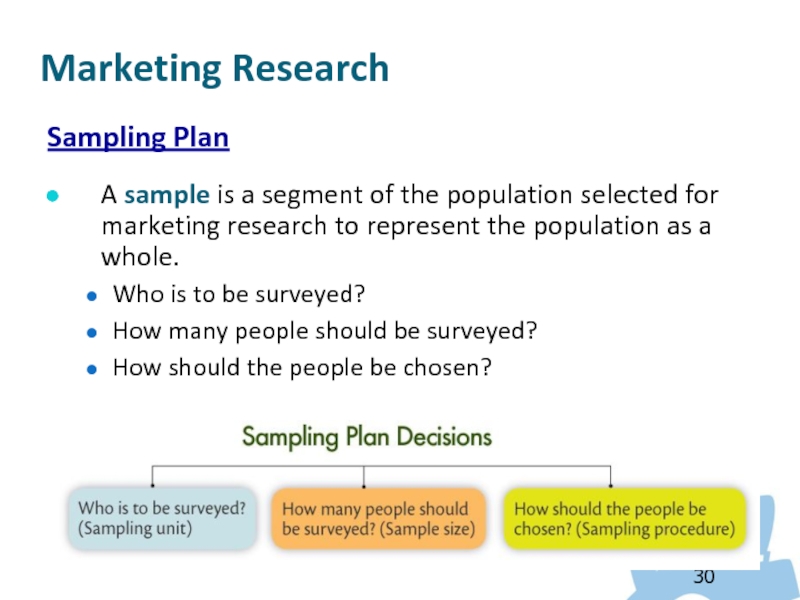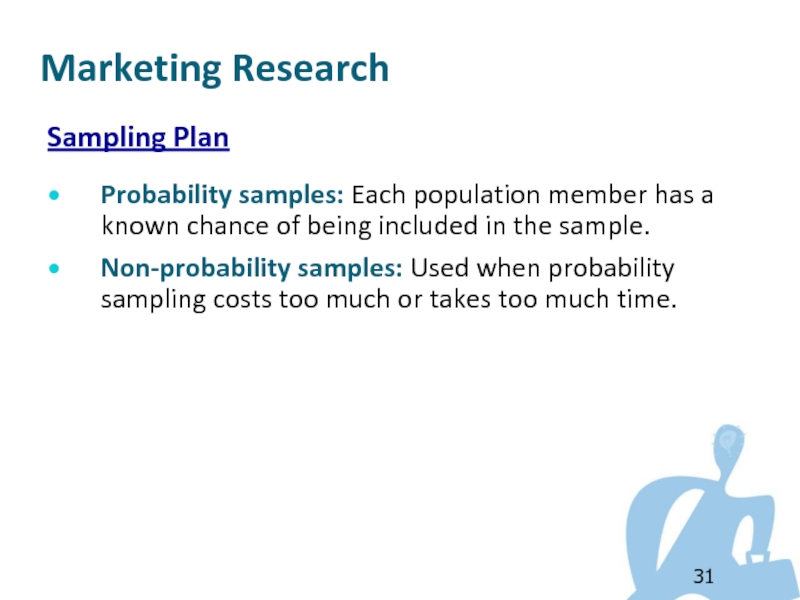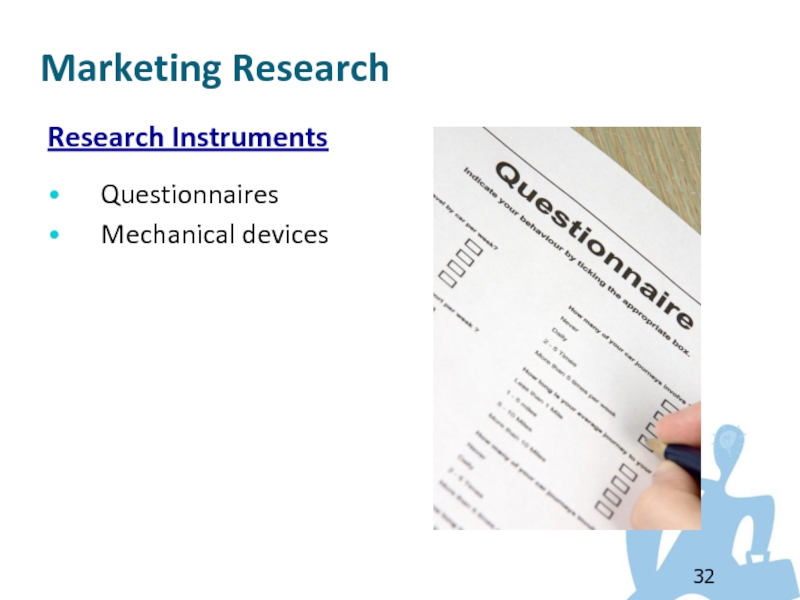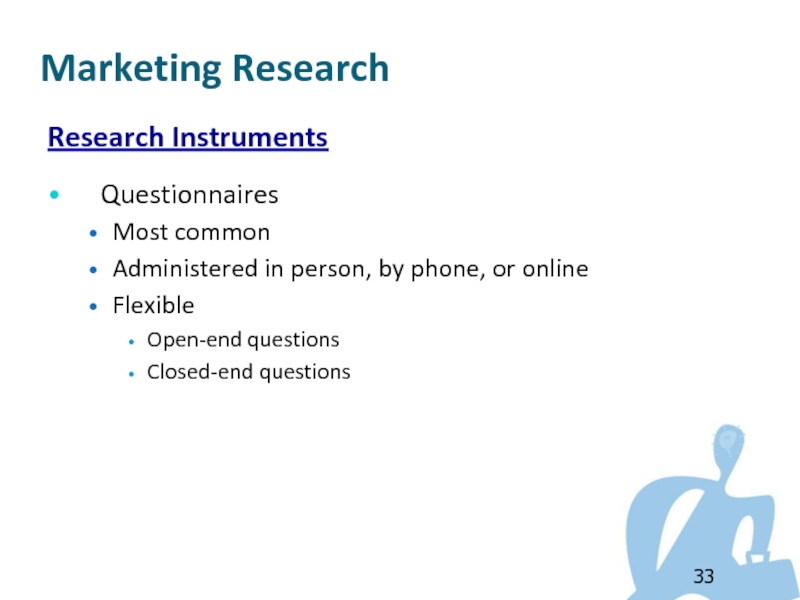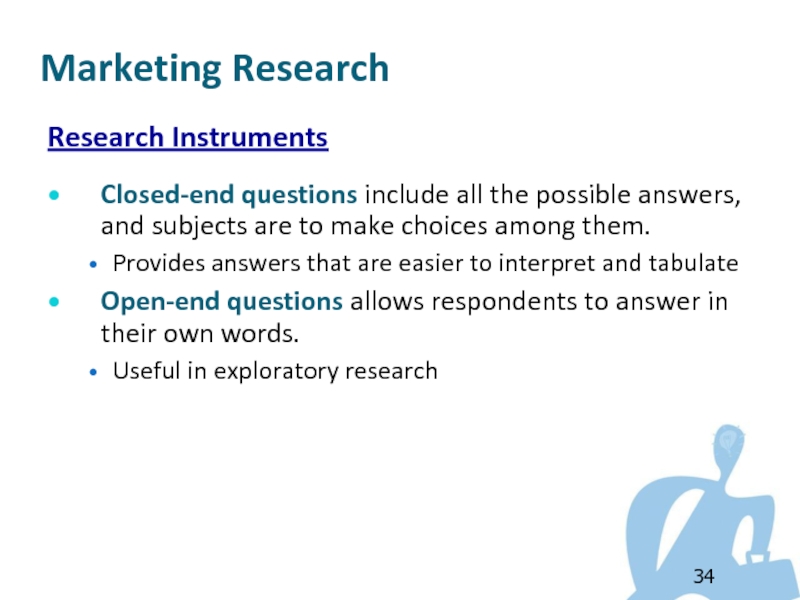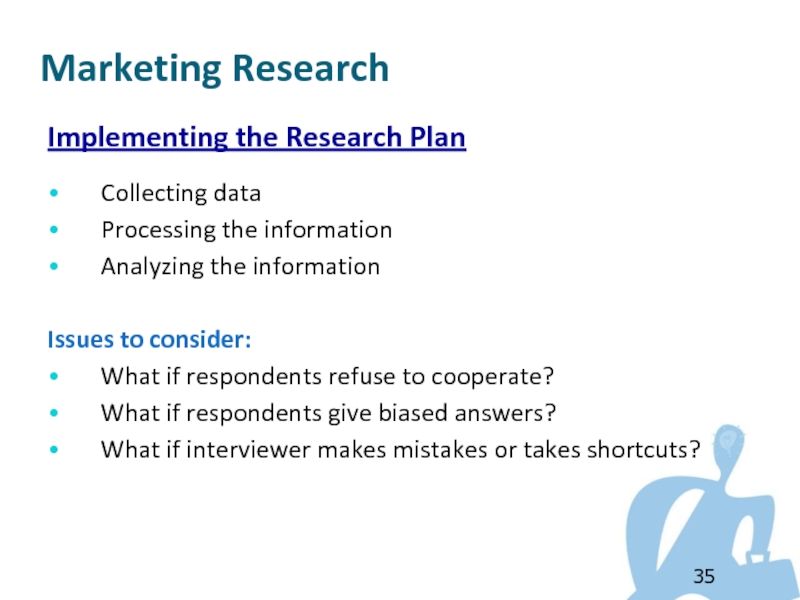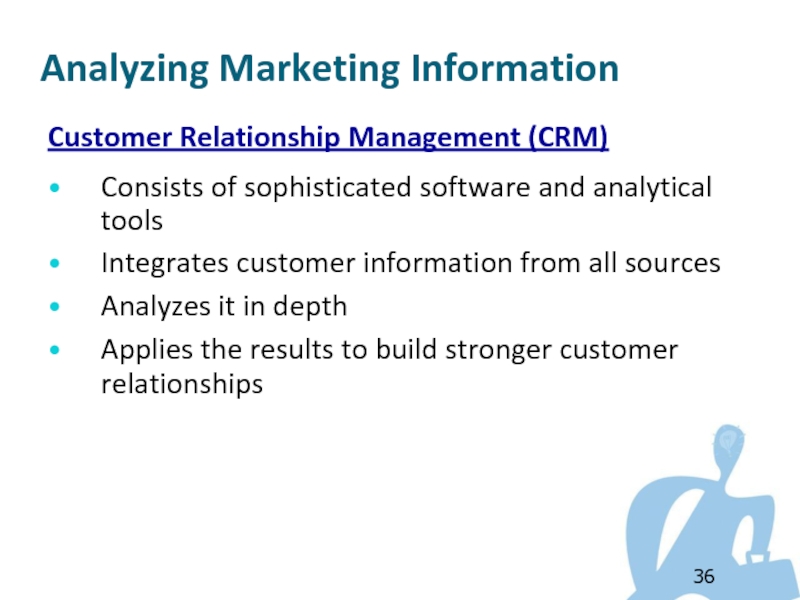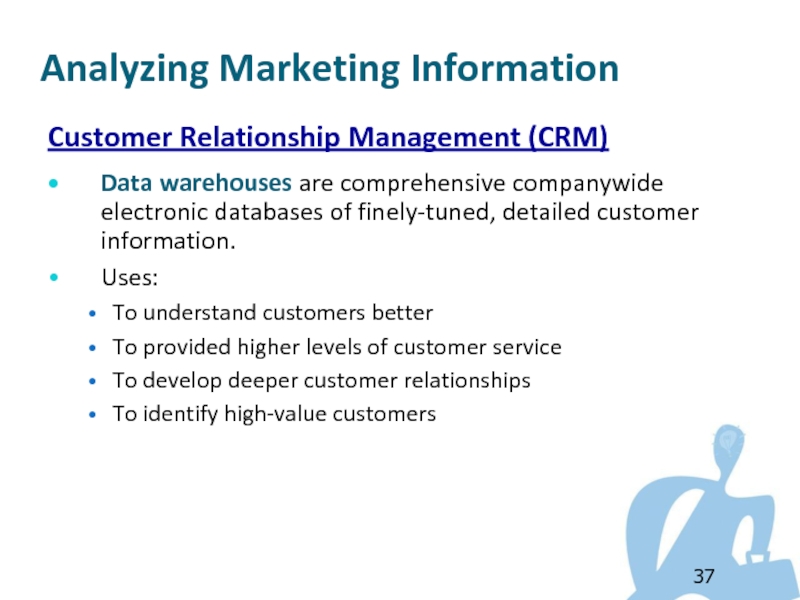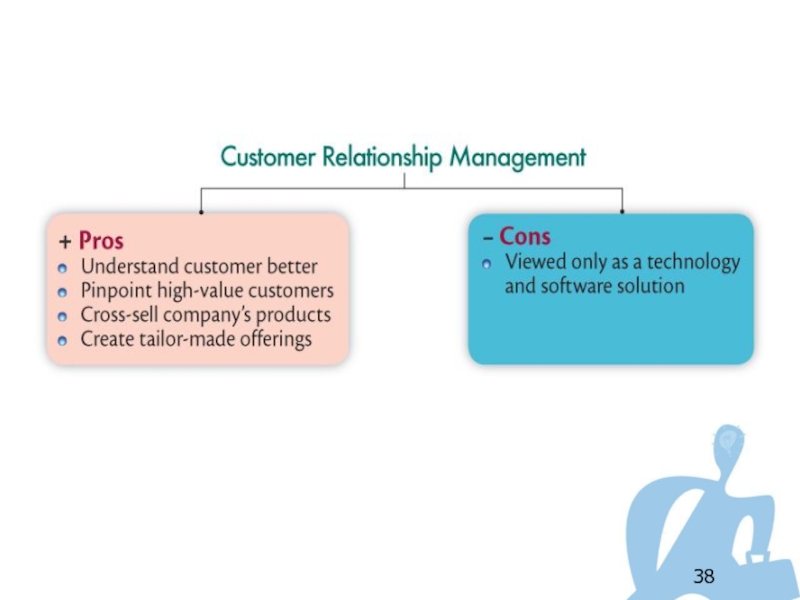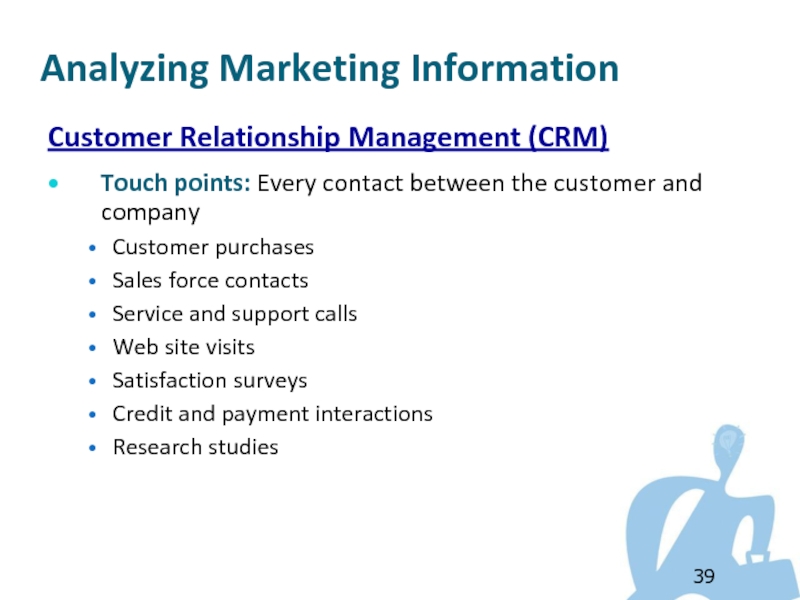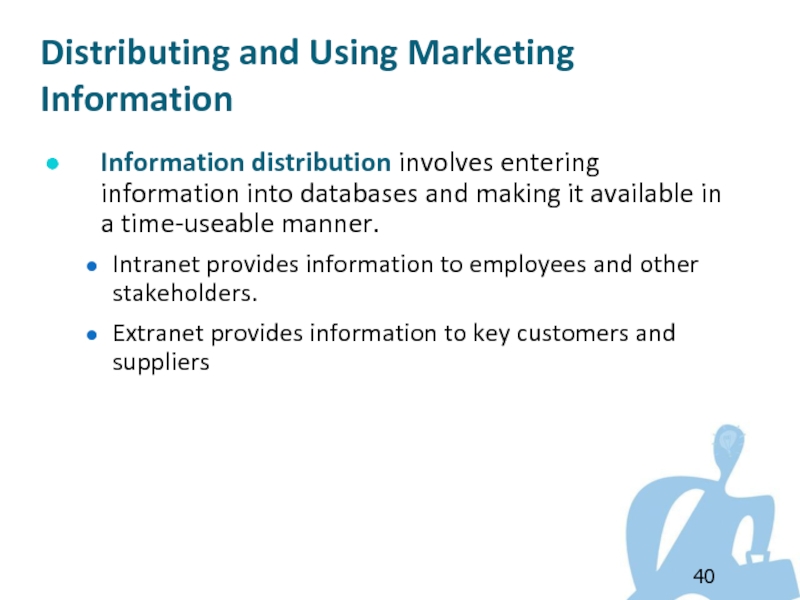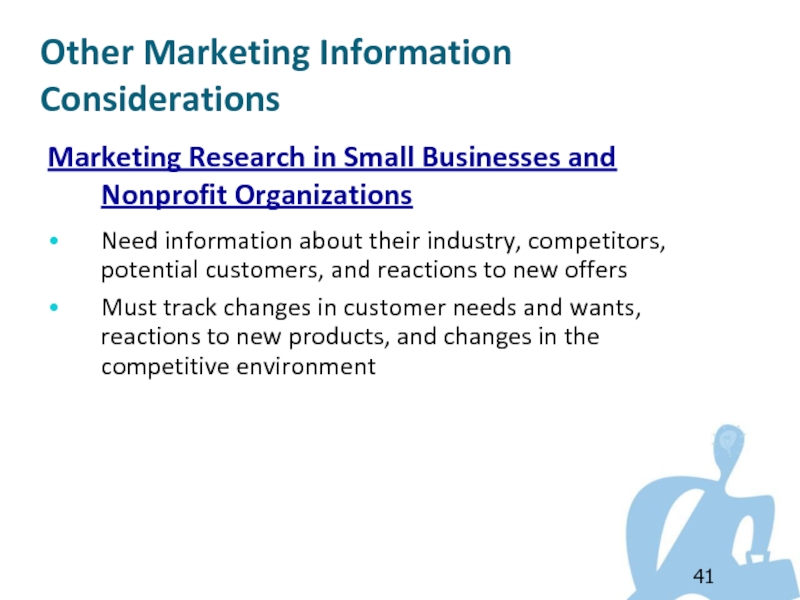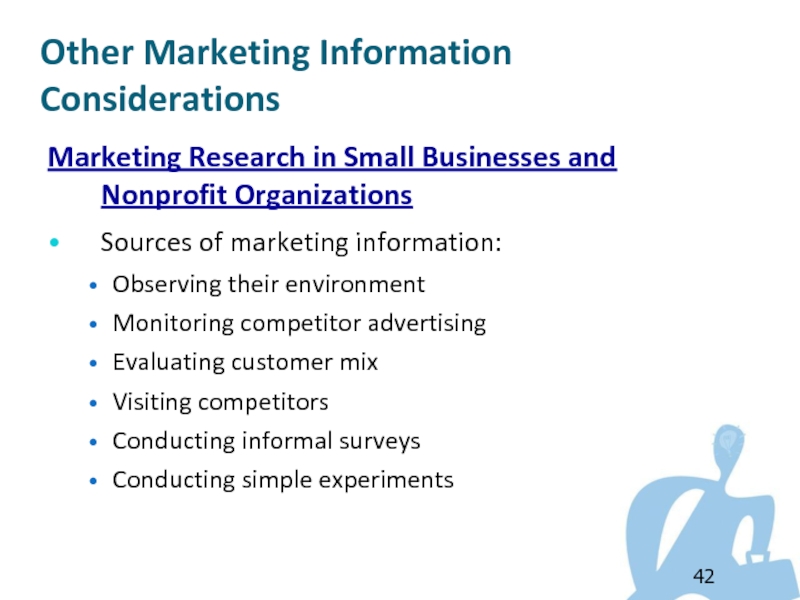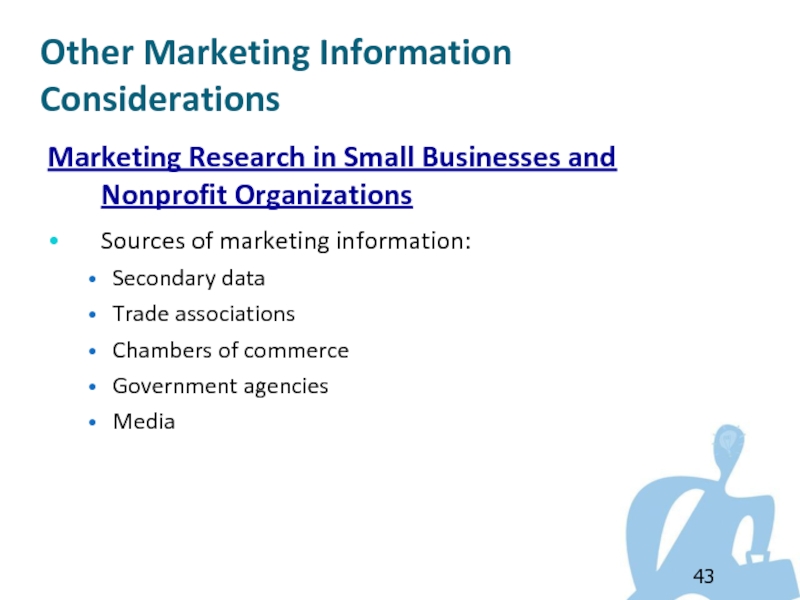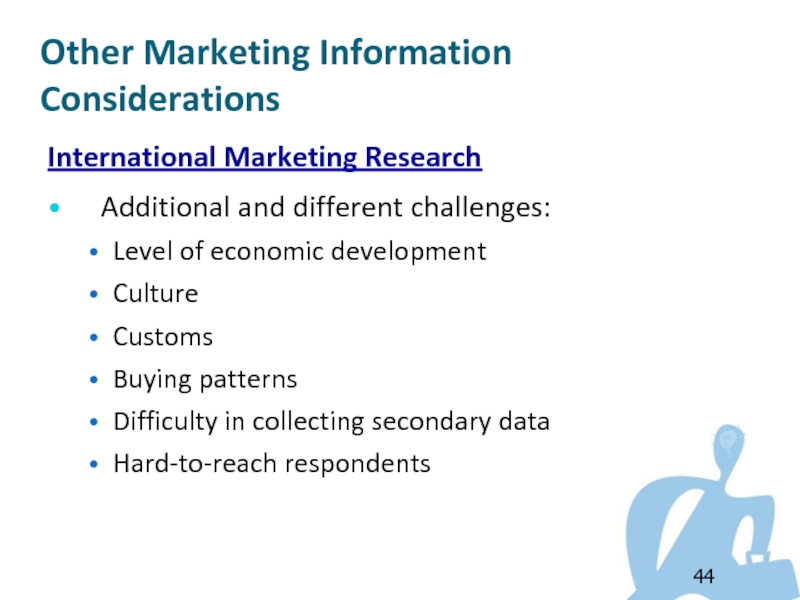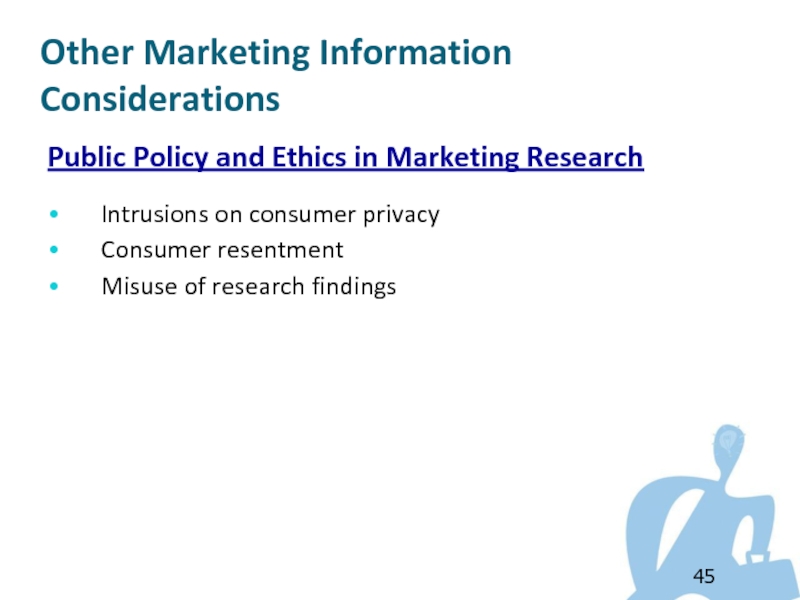- Главная
- Разное
- Дизайн
- Бизнес и предпринимательство
- Аналитика
- Образование
- Развлечения
- Красота и здоровье
- Финансы
- Государство
- Путешествия
- Спорт
- Недвижимость
- Армия
- Графика
- Культурология
- Еда и кулинария
- Лингвистика
- Английский язык
- Астрономия
- Алгебра
- Биология
- География
- Детские презентации
- Информатика
- История
- Литература
- Маркетинг
- Математика
- Медицина
- Менеджмент
- Музыка
- МХК
- Немецкий язык
- ОБЖ
- Обществознание
- Окружающий мир
- Педагогика
- Русский язык
- Технология
- Физика
- Философия
- Химия
- Шаблоны, картинки для презентаций
- Экология
- Экономика
- Юриспруденция
Managing Marketing Information. (Chapter 4.1) презентация
Содержание
- 2. Learning Objectives After studying this chapter, you
- 3. Chapter Outline Assessing Marketing Information Needs Developing
- 4. A marketing information system (MIS) consists of
- 5. Assessing Marketing Information Needs The marketing information system
- 6. Assessing Marketing Information Needs MIS provides
- 7. A good MIS balances the information users
- 8. Marketers can obtain information from: Internal data Marketing intelligence Marketing research Developing Marketing Information
- 9. Internal Data Internal databases are electronic
- 10. Advantages: Can be accessed more quickly Less
- 11. Marketing Intelligence Marketing intelligence is the
- 12. Marketing research is the systematic design, collection,
- 13. Steps in the marketing research process
- 14. Defining the Problem and Research Objectives
- 15. Defining the Problem and Research Objectives
- 16. Developing the Research Plan The research
- 17. Developing the Research Plan The research
- 18. Developing the Research Plan Secondary data
- 19. + Advantages: Speed Cost Provides data that
- 20. Primary Data Collection Research approaches Contact methods Sampling plan Research instruments Marketing Research
- 21. Research Approaches Observational research involves gathering
- 22. Research Approaches Survey research is the
- 23. Research Approaches Experimental research is best
- 24. Contact Methods Mail questionnaires Collect large
- 25. Contact Methods Telephone interviewing Collects information
- 26. Contact Methods Mail, telephone, and personal
- 27. Contact Methods Personal interviewing Individual interviewing
- 28. Contact Methods Online marketing research Internet
- 29. Contact Methods Online marketing research Low
- 30. Sampling Plan A sample is a
- 31. Marketing Research Sampling Plan Probability samples:
- 32. Marketing Research Research Instruments Questionnaires Mechanical devices
- 33. Marketing Research Research Instruments Questionnaires Most
- 34. Marketing Research Research Instruments Closed-end questions
- 35. Implementing the Research Plan Collecting data
- 36. Customer Relationship Management (CRM) Consists of sophisticated
- 37. Customer Relationship Management (CRM) Data warehouses are
- 39. Customer Relationship Management (CRM) Touch points: Every
- 40. Information distribution involves entering information into databases
- 41. Other Marketing Information Considerations Marketing Research in
- 42. Other Marketing Information Considerations Marketing Research in
- 43. Other Marketing Information Considerations Marketing Research in
- 44. Other Marketing Information Considerations International Marketing Research
- 45. Other Marketing Information Considerations Public Policy and
Слайд 2Learning Objectives
After studying this chapter, you should be able to:
Explain the
Define the marketing information system and discuss its parts
Outline the steps in the marketing research process
Explain how companies analyze and distribute marketing information
Discuss the special issues some marketing researchers face, including public policy and ethics
Слайд 3Chapter Outline
Assessing Marketing Information Needs
Developing Marketing Information
Marketing Research
Analyzing Marketing Information
Distributing and
Other Marketing Information Considerations
Слайд 4A marketing information system (MIS) consists of people, equipment, and procedures
Assess the information needs
Develop needed information
Analyze information
Distribute information
Assessing Marketing
Information Needs
Слайд 6Assessing Marketing
Information Needs
MIS provides information to the company’s marketing and
Слайд 7A good MIS balances the information users would like to have
Issues to consider:
Amount of information
Availability of information
Costs
Assessing Marketing
Information Needs
Слайд 8Marketers can obtain information from:
Internal data
Marketing intelligence
Marketing research
Developing Marketing Information
Слайд 9Internal Data
Internal databases are electronic collections of consumer and market information
Developing Marketing Information
Слайд 10Advantages:
Can be accessed more quickly
Less expensive
Disadvantages:
Incomplete information
Wrong form for decision
Timeliness of information
Amount of information
Need for sophisticated equipment and techniques
Advantages and Disadvantage of Internal Databases
Developing Marketing Information
Слайд 11Marketing Intelligence
Marketing intelligence is the systematic collection and analysis of publicly
The goal of marketing intelligence is to:
Improve strategic decision making,
Assess and track competitors’ actions, and
Provide early warning of opportunities and threats.
Developing Marketing Information
Слайд 12Marketing research is the systematic design, collection, analysis, and reporting of
Marketing Research
Слайд 13Steps in the marketing research process
Defining the problem and research objectives
Developing
Implementing the plan
Interpreting and reporting the findings
Marketing Research
Слайд 14Defining the Problem and Research Objectives
Types of objectives:
Exploratory research
Descriptive research
Causal research
Marketing
Слайд 15Defining the Problem and Research Objectives
Exploratory research is the gathering of
Descriptive research is to describe things such as market potential for a product or the demographics and attitudes of consumers who buy the product.
Causal research is to test hypotheses about cause-and-effect relationships.
Marketing Research
Слайд 16Developing the Research Plan
The research plan
Outlines sources of existing data
Spells
Marketing Research
Слайд 17Developing the Research Plan
The research plan is a written proposal that
Management problem
Research objectives
Information needed
How the results will help management decisions
Budget
Marketing Research
Слайд 18Developing the Research Plan
Secondary data consists of information that already exists
Primary data consists of information gathered for the special research plan
Marketing Research
Слайд 19+ Advantages:
Speed
Cost
Provides data that a company cannot collect on its own
Gathering
Marketing Research
– Disadvantages:
Availability
Relevance
Accuracy
Impartial
Слайд 20Primary Data Collection
Research approaches
Contact methods
Sampling plan
Research instruments
Marketing Research
Слайд 21Research Approaches
Observational research involves gathering primary data by observing relevant people,
Ethnographic research involves sending trained observers to watch and interact with consumers in their natural environment.
Marketing Research
Слайд 22Research Approaches
Survey research is the most widely used method and is
Flexible
People can be unable or unwilling to answer
Gives misleading or pleasing answers
Privacy concerns
Marketing Research
Слайд 23Research Approaches
Experimental research is best for gathering causal information
Tries to explain
Marketing Research
Слайд 24Contact Methods
Mail questionnaires
Collect large amounts of information
Low cost
Less bias with no
Lack of flexibility
Low response rate
Lack of control of sample
Marketing Research
Слайд 25Contact Methods
Telephone interviewing
Collects information quickly
More flexible than mail questionnaires
Interviewers can explain
Higher response rates than mail questionnaires
Interviewers communicate directly with respondents
Higher cost than mail questionnaires
Potential interviewer bias
Marketing Research
Слайд 26Contact Methods
Mail, telephone, and personal interviewing
Personal interviewing
Individual interviewing
Group interviewing
Marketing Research
Слайд 27Contact Methods
Personal interviewing
Individual interviewing
Involves talking with people at home or
Flexible
More expensive than telephone interviews
Group interviewing or focus group interviewing
Involves inviting 6 to 10 people to talk with a trained moderator
Marketing Research
Слайд 28Contact Methods
Online marketing research
Internet surveys
Online panels
Online experiments
Online focus groups
Marketing Research
Слайд 29Contact Methods
Online marketing research
Low cost
Speed to administer
Fast results
Good for hard-to-reach groups
Hard
Lack of interaction
Privacy concerns
Marketing Research
Слайд 30Sampling Plan
A sample is a segment of the population selected for
Who is to be surveyed?
How many people should be surveyed?
How should the people be chosen?
Marketing Research
Слайд 31Marketing Research
Sampling Plan
Probability samples: Each population member has a known chance
Non-probability samples: Used when probability sampling costs too much or takes too much time.
Слайд 33Marketing Research
Research Instruments
Questionnaires
Most common
Administered in person, by phone, or online
Flexible
Open-end questions
Closed-end
Слайд 34Marketing Research
Research Instruments
Closed-end questions include all the possible answers, and subjects
Provides answers that are easier to interpret and tabulate
Open-end questions allows respondents to answer in their own words.
Useful in exploratory research
Слайд 35Implementing the Research Plan
Collecting data
Processing the information
Analyzing the information
Issues to consider:
What
What if respondents give biased answers?
What if interviewer makes mistakes or takes shortcuts?
Marketing Research
Слайд 36Customer Relationship Management (CRM)
Consists of sophisticated software and analytical tools
Integrates
Analyzes it in depth
Applies the results to build stronger customer relationships
Analyzing Marketing Information
Слайд 37Customer Relationship Management (CRM)
Data warehouses are comprehensive companywide electronic databases of
Uses:
To understand customers better
To provided higher levels of customer service
To develop deeper customer relationships
To identify high-value customers
Analyzing Marketing Information
Слайд 39Customer Relationship Management (CRM)
Touch points: Every contact between the customer and
Customer purchases
Sales force contacts
Service and support calls
Web site visits
Satisfaction surveys
Credit and payment interactions
Research studies
Analyzing Marketing Information
Слайд 40Information distribution involves entering information into databases and making it available
Intranet provides information to employees and other stakeholders.
Extranet provides information to key customers and suppliers
Distributing and Using Marketing Information
Слайд 41Other Marketing Information Considerations
Marketing Research in Small Businesses and Nonprofit Organizations
Need
Must track changes in customer needs and wants, reactions to new products, and changes in the competitive environment
Слайд 42Other Marketing Information Considerations
Marketing Research in Small Businesses and Nonprofit Organizations
Sources
Observing their environment
Monitoring competitor advertising
Evaluating customer mix
Visiting competitors
Conducting informal surveys
Conducting simple experiments
Слайд 43Other Marketing Information Considerations
Marketing Research in Small Businesses and Nonprofit Organizations
Sources
Secondary data
Trade associations
Chambers of commerce
Government agencies
Media
Слайд 44Other Marketing Information Considerations
International Marketing Research
Additional and different challenges:
Level of economic
Culture
Customs
Buying patterns
Difficulty in collecting secondary data
Hard-to-reach respondents
Слайд 45Other Marketing Information Considerations
Public Policy and Ethics in Marketing Research
Intrusions on
Consumer resentment
Misuse of research findings
